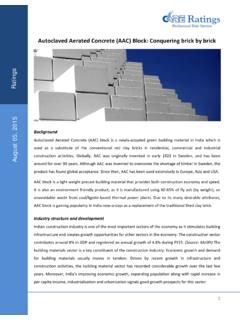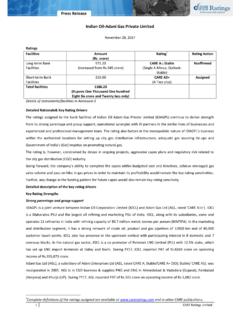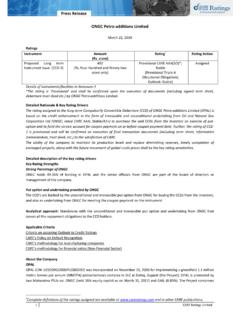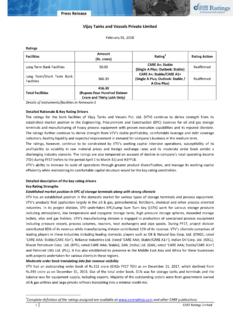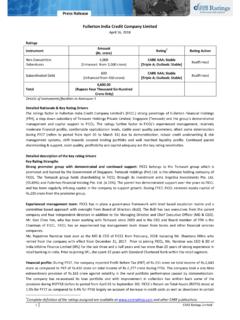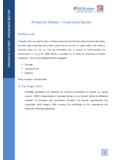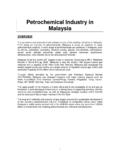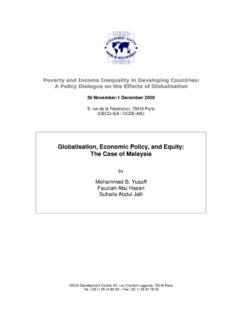Transcription of Outlook of Indian Edible Oil Industry - CARE’s Ratings
1 Outlook of Indian Edible Oil Industry Summary Edible oils constitute an important component of food expenditure in Indian households. Edible oil Ratings Industry is one of the most important industries of agriculture sector in India. India is a leading player in the Industry , with world's largest importer from Indonesia and Malaysia and third largest consumer. India is the fourth largest oil seed-producing country in the world after USA, China and Brazil. In all, nine types of oilseeds are produced in India. Of the nine, soya bean, ground nut, and mustard are the major oilseeds produced in the country. The growth of Edible oil consumption and increasing July 15, 2016. population coupled with limited availability of oil seeds and shifting of acreage to other crops have resulted in continuous demand supply gap for Edible oil which is being met by imports. Further import of Edible oil is subject to change in custom duty rates between crude oil and refined oil which can affect domestic producers and refiners.
2 Apart from Indian custom duty rates, Indian Edible oil Industry is also susceptible to the policies of Indonesia and Malaysia, the two largest exporting countries of Edible oil. The article delineates on various reasons for decline in Edible oil production along with prospects, issues and challenges faced by the Industry . Overview of Indian Edible oil Industry India plays an important role in the global Edible oil market, accounting for 10-12% share of consumption; 6-8% share of oilseed production; 4-6% share of Edible oil production, and 12-14% share of world Edible oil imports for OY151. Furthermore, the Industry is highly dependent on availability of raw material, domestic production of oil seeds, annual rainfall, global price fluctuations and consumer preferences. Availability of Edible oil in India has shown a compound annual growth rate (CAGR) of during OY06-OY15 with y-o-y growth of in OY15 over OY14, whereas the growth in population has remained at CAGR of during 2006-2015.
3 Majority of the demand supply gap of Edible oil in India is being filled through imports. 1. 1. OY Oil Year refers to the period of November to October Ratings Demand supply gap of Edible oil in India Source: CMIE & Complied by CARE. The growth in production of domestic Edible oil has not been able to keep pace with the growth of consumption. Thus, this gap is being met by the imports that account for almost 55-65% of the total oil consumption during past five years. Continuous increase in the gap between demand and supply of Edible oil has forced India to do huge import from leading exporter countries of Edible oil. The demand supply gap is becoming wider mainly due to limited availability of oil seeds, shifting of acreage to other crops and increase in demand of Edible oil. More than 14 million tonnes of Edible oil was Import of Edible oil during 2014-15. imported with a total value of , crore efined during OYFY15.
4 In terms of volumes, crude Edible Oil oil contributes about 89% and refined oil 10%. Crude contributes about 11% of the total import during Palm oil OYFY15. Of the 89% of imported crude Edible oil, 61%. Crude Oil Other palm oil, soybean oil and sunflower oil contributes 90% 4%. about 54%, 21% and 11%, respectively. India is Sunflower importing Edible oil from Indonesia, Malaysia, oil Soybean Argentina and Ukraine contributing about 36%, 12% oil 23% 23%, 17% and 13%, respectively, of total imports. Source: CMIE. Outlook of Indian Edible Oil Industry 2. Ratings Demand of Edible oil is mainly driven by increase in per capita consumption of Edible oil, rising income levels and improvement of living standards. However, the Indian Edible oil market continues to be underpenetrated as current per capita consumption level of India (at Kg/year for 2014-15) is much lower than global averages (24. kg/year). Furthermore, domestic consumption of Edible oil is expected to increase with enhancement in income level and population.
5 Constraints in oilseeds production 1. Oilseed crops are largely grown under rain-fed condition (>70%) and are more prone to biotic and a-biotic stresses. Only one fourth of oilseed producing area remains under the irrigation. 2. Oilseeds are energy rich crops but are grown under energy starved conditions (with minimum inputs with high risk). 3. Majority of oilseed growers (more than 85%) are small and marginal farmers having poor resource base. 4. High seed rate (number of seeds (Kg) to be used per hector or acre for maximum yield) and cost of seeds coupled with non-availability of quality seeds of varieties and hybrids. 5. Limited adoption of improved varieties and technologies. 6. Unorganized marketing infrastructure and procurement mechanism. 7. External price shock on account of dependence on import is a major challenge in this sector. 8. The cultivation of oil seed farms such as palm has long gestation period of about 3-7 years before the cultivators could actually begin to derive benefit from thereof.
6 Trend of refined and crude oil import in terms of volumes and duty The current duty differential between CPO and RBD (refined, bleached, and diodized) stands at , which provides protection to domestic refiners against competition from imported refined oils to certain extent. Source: CMIE & Ministry of Consumer Affairs, Food & Public Distribution GOI. Outlook of Indian Edible Oil Industry 3. Ratings The increase in export duty by Indonesia on CPO has adversely affected the refining industries in India due to narrowing spread between crude and refined oil in global markets OY15. The spread during Q3FY14 between CPO. and RBD has narrowed to as low as about $10 a tonne, thus adversely impacting the profitability margins of domestic refining industries as most of the domestic trades have sought for import of RBD than purchasing from domestic players. In order to counter the same during January 2014, Indian government has raised the import duty on RBD to 10% from , while that on CPO was kept unchanged at resulting in increase in differential duty between RBD and CPO at from 5%.
7 Furthermore, import duty for RBD was increased to 20% from 15%. and for CPO it was increased to from during September 2015. Thus, net duty differential was being maintained at to protect the domestic Industry . Going forward, the Industry 's profitability is vulnerable to any reduction in this duty differential. Intervention of Government to tackle import of Edible oil Government of India is promoting National Mission on Oilseeds and oil palm (NMOOP) during 2012-17 to achieve objectives such as increasing Seed Replacement Ratio (SRR) in oil crops with focus on Varietal Replacement, increasing irrigation coverage under oilseeds from 26% to 36%, diversification of area from low yielding cereals crops to oilseeds crops, inter-cropping of oilseeds with cereals/ pulses/ sugarcane, use of fallow land after paddy/potato cultivation, expansion of cultivation of oil palm and tree borne oilseeds in watersheds and wastelands, increasing availability of quality planting material enhancing procurement of oilseeds and collection, and processing of tree borne oilseeds.
8 The cost of interventions under the mission was in the ratio of 75:25 between center and states. However, for components like seed production, Front Line Demonstration (FLD), mini-kits, adaptive research being implemented through central agencies such as State Agricultural Universities (SAU) and Indian Council of Agricultural Research (ICAR) institute are being funded through 100% central support. There are three mini missions in this scheme viz. Mini-mission-I, II and III. Mini Mission-I focuses on oilseeds, Mini Mission II on oil palm and Mini Mission III on tree-borne oilseed (TBOs). The mission aims to enhance production of oilseed from million tonnes (average of 11th five year plan) to million tonnes by 2016-17 and to bring additional area of lakh hectare under oil palm cultivation with increase in productivity of Fresh Fruit Bunches (FFB) from 4927. kg/ha to 15,000 kg/ha by end of 12th five year plan. Conclusion: Indian Edible oil Industry has witnessed financial stress due to droughts, rising production costs and cheaper imports thus forcing several small firms to shut shop.
9 India imports nearly 67% of its Edible oil requirements; the rest is being met from domestic expansion under palm oil fell by over 50% over the last couple of years due to low prices of crude palm oil and poor rainfall. Though the duty differential between crude and Outlook of Indian Edible Oil Industry 4. Ratings refined palm oil is , Edible oil sellers are finding it more convenient to import refined palm oil directly from Malaysia and Indonesia and sell it in the domestic market thus placing the Edible oil processing units to operate at hair line margins or in worst case scenario wherein the units are small the operations have become unvailable. The performance of the companies in Edible oil sector for medium term period will depend upon the demand of CPO in India post recent increase in import duties on refined Edible oils, movement of domestic Edible oil prices, performance of Indian Rupee against US Dollar, anticipated sales volumes and profitability margins from the specialty fats business with comprehensive product range including bakery shortening's, chocolate &.
10 Confectionary fats, ice cream fats and a range of cooking oils. Outlook : The long-term Outlook of Edible oil demand in India is favorable on expectation of increasing population, increase in per capita consumption which in turn would be driven by changing lifestyles, growing urbanization, increasing proportion of middle-class population and steadily rising affluence levels. The near-term Outlook for the Edible oil companies is expected to be stable on steady Edible oil domestic demand and improvement in operating margin due to increasing refining operation. Rating Dispersion CARE's Ratings in the Edible oil sector fall predominantly in the BBB , BB and B categories on account of small scale of operations of the entitites, susceptibility of profitability to volatility in raw material prices and intense competition. As depicted below, of the total 67 Edible oil companies rated by CARE as on July 11, 2016, about 35% fall under the investment grade' category.


